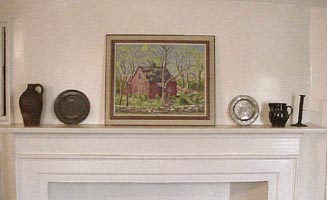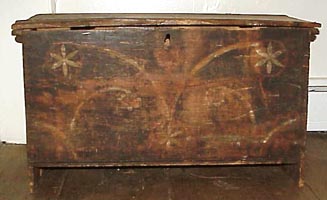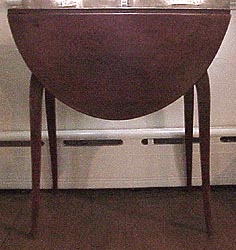| Join | Official Historian | City of Stamford | Blog | About Us | |
| Jewish Historical Society | Civil War Roundtable | Contact Us | |
|
|
|
|
The Stamford Historical Society: The Hoyt Barnum HouseA Virtual Tour through the Hoyt Barnum House
The Hoyt
Barnum House has recently been cleaned and refurbished with17th and 18th century
furniture.
|
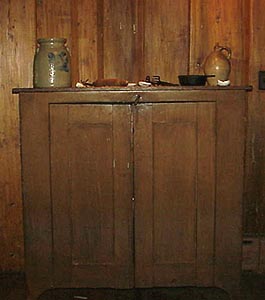 |
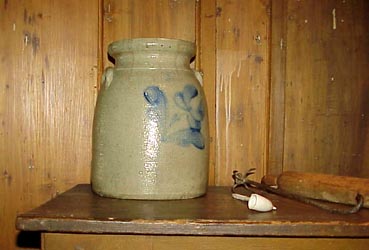 |
William and Mary Gate-leg Table. Made of maple, probably in New York, circa 1720-1760. It has D-shaped leaves and double ring and vase turned legs which end in ball feet.
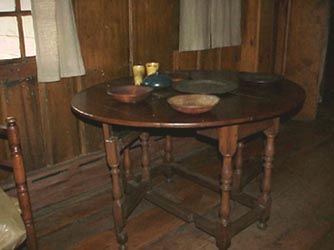
On the table is a collection of handmade wooden plates and bowls (often referred to as treen) as well as a large pewter plate and horn cups.
Ladder Back Arm Chair. Made of maple and ash in Connecticut between 1750 and 1820. This chair has a serpentine crest, solid vase splat, sausage and ring-turned legs with flaring feet joined by a ball and reel-turned front stretcher. This would have been the Father's chair.
The Fireplace
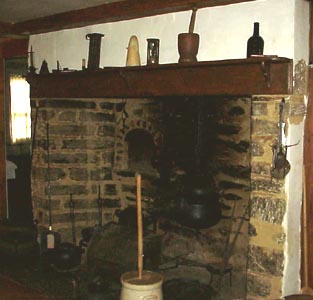 Many
cooking utensils and tools were needed to prepare family meals. Most homes would
not have had all of the ones shown here. While none of the metal items are believed
to be made by Samuel Hoyt, the builder of the house, he was, by profession,
a blacksmith and was occupied in making similar utensils. There are some of
the special items to be found on the hearth and on the mantel:
Many
cooking utensils and tools were needed to prepare family meals. Most homes would
not have had all of the ones shown here. While none of the metal items are believed
to be made by Samuel Hoyt, the builder of the house, he was, by profession,
a blacksmith and was occupied in making similar utensils. There are some of
the special items to be found on the hearth and on the mantel:
Gooseneck Andirons. Dating to the 18th century, these wrought iron andirons came from the Pratt family of Pratt Island, which lies just off the Stamford/Darien coastline.
High-legged Trivet. Circa 1775-1790. This wood handled one would not have been set into the ashes, but would have sat on the hearth to hold a pot or pan to keep the contents warm. Not surprisingly, the wood handle is badly burned.
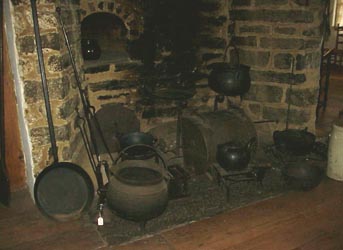 Tin
Candle Mold. The
use of molds made candlemaking much less time consuming than hand dipping.
This six taper model held six lengths of cotton wicking threaded into the
small holes
on the bottom and then secured by two sticks laid across the top. Melted wax
or tallow was then poured into the mold and allowed to harden.
Tin
Candle Mold. The
use of molds made candlemaking much less time consuming than hand dipping.
This six taper model held six lengths of cotton wicking threaded into the
small holes
on the bottom and then secured by two sticks laid across the top. Melted wax
or tallow was then poured into the mold and allowed to harden.
Betty Lamp. This was a handy source of light. This one is made of tin. The shallow, cup-like font holds the oil in which floats a wick of twisted cotton.
Hour Glass. An 18th century timepiece made of blown glass in a pine frame. It was found near Lisbon, Connecticut.
The Bedroom
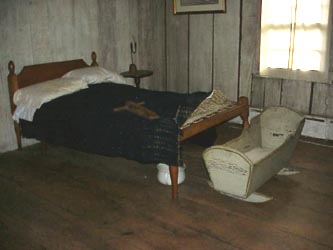 Folding
Rope Bed. The early
maple bed features a headboard with simple pineapple finials. There is no footboard.
Ropes supported the straw tick or feather mattress and had to be pulled taut
to hold the bed frame together. There would undoubtedly have been a trundle
bed under this bed to provide sleeping room for young children. It would
be
pulled out at night and slid under the bed in the daytime to allow more space
for daily household activities. The 1738 inventory of Samuel Hoyt's estate
lists
a trundle bed.
Folding
Rope Bed. The early
maple bed features a headboard with simple pineapple finials. There is no footboard.
Ropes supported the straw tick or feather mattress and had to be pulled taut
to hold the bed frame together. There would undoubtedly have been a trundle
bed under this bed to provide sleeping room for young children. It would
be
pulled out at night and slid under the bed in the daytime to allow more space
for daily household activities. The 1738 inventory of Samuel Hoyt's estate
lists
a trundle bed.
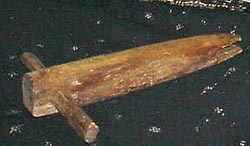 Bed
Wrenches. Three varying
sizes are on display. They were an absolute necessity to keep the bed ropes
tight. Herein lies the origin of the nighttime phrase still used today, sleep
tight.
Bed
Wrenches. Three varying
sizes are on display. They were an absolute necessity to keep the bed ropes
tight. Herein lies the origin of the nighttime phrase still used today, sleep
tight.
William and Mary Chest. A rectangular, lift-top chest made of oak and pine and stained brick red. It is probably of English origin and dates to the late 17th century. It has paneled front and sides; the stiles continue downward to form legs. The incised decoration is of demi-lune design.
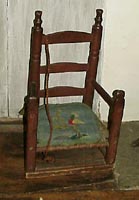 |
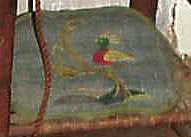 |
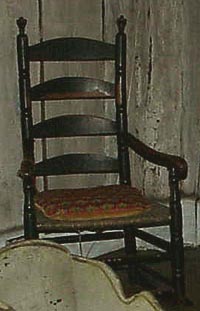 Slat
Back Rocking Chair. The chair dates to the 18th century with the rockers
added at a later date. The original rush seat is well-worn. Provenance: unknown.
The Bargello needlepoint
cushion was made by Avis Gardiner.
Slat
Back Rocking Chair. The chair dates to the 18th century with the rockers
added at a later date. The original rush seat is well-worn. Provenance: unknown.
The Bargello needlepoint
cushion was made by Avis Gardiner.
Child's Slat Back Chair. This mid-18th century chair retains its original red paint and is marked J.P., for John Parsons, on three of the back slats. The front legs are flat so the chair could be used as a child's walker, pushing it along a bare floor. John Parsons came from England to Massachusetts; then came down to Connecticut and on to New York. He advertised in the New York papers in 1754 as a cabinetmaker. The embroidered cushion was made by Avis Gardiner, a prominent Stamford antiquarian and dealer in American antiques.
Painted Pine Cradle. This gray painted cradle with simple green trim dates to the 19th century. The plank sides rake inward and the rockers are D-shaped.
Ratchet Candlestand. Dating to the early 18th century, this oak candlestand was handmade using small wooden pegs throughout. It has a carved “X” base. Two tin cups were set into the original candle sockets which had burned and were no longer useable. The stand could be adjusted to provide light at the proper height.
T-base Maple Candlestand. The circular tabletop stands on a turned pedestal and shows evidence of original green paint. Acquired as a memorial to Grace Leach, Hospitality Chairman of the Stamford Historical Society for many years.
Three-legged Stool. Stools and simple small benches were easy to make at home and provided portable seating for children in most early homes. Provenance unknown.
Small Household Items. The bootjack, curling iron, chamber pot, small domed box and saucer candlestick warrant the viewer's interest. Saucer candlesticks were very practical when carrying lighted candles from room to room. The hot wax would fall into the saucer instead of onto the hand of the carrier.
Andirons. Loop top andirons, made circa 1800. The feet are deeply arched.
Small Domed Box. Painted gray and lined with newspaper. This was found in a tumbledown house (purported to be haunted) on Ponus Ridge in New Canaan, CT in 1890.
Rush Light and Candleholder. 17th century, handwrought by a blacksmith. The hand carved oak base is a replacement. This combination candleholder could burn either a candle or rush (plant material found in marshes) that had been dipped in grease and clamped in the tongs. Provenance unknown.
The Buttery
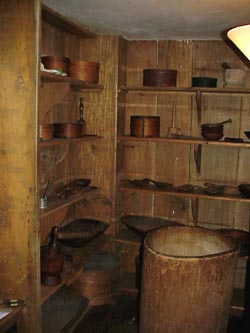 This
small room adjacent to the keeping room holds many of the utensils needed
for
food preparation. One of the major household jobs was making butter and cheese.
(Samuel Hoyt's inventory lists four cows). Butter was churned from the heavy
cream which rose to the top of fresh milk after standing for some hours or
days
in shallow earthenware or tin dishes on cool pantry shelves. After skimming
it off, the cream was put in the churn, which was often made of wood as well
as stoneware. It was “churned” by moving a wooden dasher up and down—a tedious job often assigned to younger family members. The butterfat in
the cream eventually formed into clumps. It was then transferred to a bowl where
it was “worked” with a butter paddle to remove any remaining liquid
(buttermilk). This ensured that the butter would keep well and remain sweet.
It was then packed into containers—crockery or wood. It was sometimes packed
into fancy molds with carved designs to imprint the butter.
This
small room adjacent to the keeping room holds many of the utensils needed
for
food preparation. One of the major household jobs was making butter and cheese.
(Samuel Hoyt's inventory lists four cows). Butter was churned from the heavy
cream which rose to the top of fresh milk after standing for some hours or
days
in shallow earthenware or tin dishes on cool pantry shelves. After skimming
it off, the cream was put in the churn, which was often made of wood as well
as stoneware. It was “churned” by moving a wooden dasher up and down—a tedious job often assigned to younger family members. The butterfat in
the cream eventually formed into clumps. It was then transferred to a bowl where
it was “worked” with a butter paddle to remove any remaining liquid
(buttermilk). This ensured that the butter would keep well and remain sweet.
It was then packed into containers—crockery or wood. It was sometimes packed
into fancy molds with carved designs to imprint the butter.
Storage shelves display. Mortars and pestles for grinding spices, herbs and grains; bowls in many sizes and shapes including some large elongated bowls used for rising bread dough; covered pantry boxes, often made in nested sets; wooden lemon squeezer; potato mashers; sieves, rolling pins; stoneware and redware pottery.
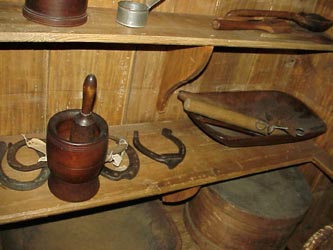 |
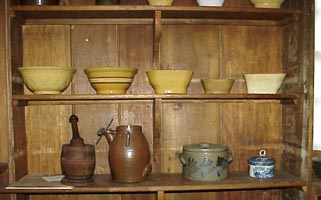 |
Photos © Stamford Historical Society
Information
about the Hoyt-Barnum House
Archaeological dig
Roof restoration
